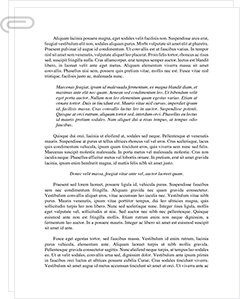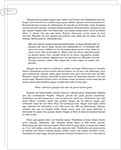 Study Document
Study Document
Bacteriological Analysis Of Water Tanks In Residential Areas Essay
Pages:8 (2351 words)
Document Type:Essay
Document:#336740
Essay Topic Examples
1. The Prevalence and Dangers of Coliform Bacteria in Residential Water Tanks:
This essay would explore the presence of coliform bacteria in residential water tanks, identifying the types commonly found, like Escherichia coli. The focus would be on the implications for public health, the risks of waterborne diseases, and the conditions that favor the growth of these pathogens.
2. Impact of Water Storage Practices on Bacteriological Quality in Residential Areas:
An analysis of how water storage methods, such as the material of the tanks and maintenance routines, affect the bacterial content of stored water. This topic could also delve into the influence of environmental factors like temperature and explore potential interventions for improving storage practices.
3. Advances in Bacteriological Analysis Techniques for Ensuring Safe Water Supply:
This essay would examine the latest methods for detecting contaminants in water tanks, including molecular techniques like PCR, traditional culture methods, and rapid testing kits. The discussion could assess the efficacy, cost, and practicality of these techniques for routine monitoring.
4. A Comparative Study of Urban vs. Rural Residential Water Tank Contamination:
A comparison of bacteriological contamination levels in urban and rural residential water tanks, considering factors such as population density, infrastructure, and access to clean water. The essay would investigate how these factors influence bacterial profiles and what measures could be implemented to address disparities.
5. The Role of Water Tank Cleaning Policies in Maintaining Bacteriological Safety:
Discussing the importance of regulatory frameworks and cleaning schedules for water tanks, this essay would evaluate the effectiveness of existing policies and the compliance of residential areas. It could also suggest improvements in policy-making and enforcement to ensure safe drinking water standards.
Essay Title Examples
1. Unseen Risks: A Study of Bacterial Contamination in Residential Water Tanks
2. The Invisible Invaders: Evaluating Bacteriological Safety in Domestic Water Storage
3. Microbial Menace: Assessing Health Hazards in Home Water Supply Systems
4. Home Hygiene: Bacteriological Analysis and Quality Control of Residential Water Tanks
5. Drops of Danger: Investigating Bacterial Presence in Residential Water Storage Facilities
Essay Hook Examples
1. Imagine a single drop of water from your tap revealing a complex microbial world - a world where the health of your family may hang in the balance.
2. As pure as water may seem, lurking within the shadows of residential water tanks, there exist microscopic entities with the potential to cause unseen turmoil.
3. Would you drink from your water tank if you knew what lived inside it? A bacteriological analysis might make you think twice about what you consume.
4. Every sip of water is a journey through a biological ecosystem, often starting from the overlooked reservoirs on our rooftops.
5. The water tank in your home - an overlooked vessel or a breeding ground for potential pathogens? The answers lie in a detailed bacteriological scrutiny.
Thesis Statement Examples
1. The prevalence of pathogenic bacteria in residential water tanks is directly correlated with inadequate maintenance and cleaning practices, necessitating stricter local governance on water tank hygiene to ensure public health safety.
2. Advanced bacteriological analysis of residential water tanks reveals a surprising diversity of microorganisms, indicating that current water treatment protocols are insufficient for the eradication of all potential bacterial hazards.
3. The correlation between bacterial contamination in residential water tanks and the incidence of waterborne diseases demonstrates the urgent need for improved water quality monitoring and the implementation of new disinfection technologies.
4. Seasonal variations in temperature and humidity play a critical role in the bacterial colonization of residential water tanks, requiring dynamic adjustments to water treatment regimens to guarantee year-round safety.
5. The resistance of certain bacteria to conventional chlorination in residential water tanks highlights the necessity for implementing multi-barrier approaches, including UV radiation and filtration, to address the evolving challenge of bacteriological contamination.
Essay Outline Examples
I. Introduction
Background and Importance
Water quality concerns and public health
Historical perspective on water contamination
Purpose of Bacteriological Analysis
Identifying potential harmful bacteria presence
Assessing the safety of drinking water
II. Body
Methodology of Water Sampling
Sampling techniques and materials used
Transportation and preservation of samples
Testing Procedures for Bacteria
Common bacterial indicators of contamination
Interpretation of lab results
Findings and Discussions
Variability across different residential areas
Correlation to reported health incidences
III. Conclusion
Summary of Findings
Prevalence of bacteria in water tanks
Implications for public health and recommendations
Future Directions
Potential improvements in water treatment
Areas for further research
Essay Introduction Examples
Introduction Paragraph 1
Water is an essential element for human survival, and it is crucial that the water we consume is free from harmful bacteria and other contaminants. In residential areas, water tanks are commonly used to store water for domestic purposes. However, these water tanks can become breeding grounds for bacteria if proper maintenance and cleaning are not regularly carried out. Bacteriological analysis of water tanks in residential areas is therefore important to ensure that the water being stored is safe for consumption.
Bacteriological analysis of water tanks involves testing the water for the presence of bacteria such as E. coli, coliforms, and Legionella. These bacteria can cause a range of illnesses if consumed or inhaled, and can be particularly harmful to vulnerable populations such as children, the elderly, and individuals with weakened immune systems...
Introduction Paragraph 2
Ensuring the safety of drinking water in residential areas is a critical public health concern, particularly when it comes to the risk of bacterial contamination. Bacteria such as E. coli, coliforms, and Legionella can enter water tanks through a variety of sources, including dirt, animal waste, and decaying organic matter. By assessing the bacteriological quality of water in residential tanks, researchers and authorities can identify potential risks to public health and implement strategies to minimize exposure to harmful bacteria...
Essay Body Examples
Paragraph 1
Water tanks in residential areas represent a critical node in the provision of safe and reliable water supply, making their integrity crucial for public health. Bacteriological analysis of these water storage systems is an essential preventative measure to ensure the absence of pathogenic microorganisms that can lead to waterborne diseases. Various types of bacteria, including coliforms, E. coli, and Legionella, can be unknowingly harbored in these tanks, thereby posing a significant health risk to communities. This essay delves into the methodologies employed in the bacteriological analysis of water tanks, the implications of findings for residential health and safety, and the subsequent actions required to maintain the microbial quality of water. Such analyses are not only vital for guaranteeing the potability of water but also serve as an indicator of the overall efficacy of water storage and distribution systems in residential settings...
Paragraph 2
As urban populations continue to expand, ensuring the safety of domestic water supplies has become a heightened public health priority. Bacteriological analysis forms a cornerstone in safeguarding community health…
…the bacteriological purity of our water supplies. As custodians of our communal health and wellbeing, we must act decisively to address these findings, not only by adjusting current policies but also by reinforcing the role of community awareness and participation in maintaining water hygiene. This analysis, therefore, serves as a clarion call for immediate and sustained action in the stewardship of our most precious resource water...
Conclusion 2
In light of the findings presented, it is clear that the quality of water within residential tanks is a matter of public concern that warrants immediate and ongoing attention. The discovery of bacterial contaminants in water storage systems highlights the urgent need for proactive measures to prevent potential health hazards. This essay has rigorously detailed the necessity of continuous water quality assessments, the reinforcement of regulatory frameworks, and the advancement of water treatment technologies. Moving forward, it is crucial for community leaders, residents, and health officials to unite in a concerted effort to enhance water sanitization protocols. Adopting a community-driven approach to water safety education and regulation can significantly diminish the risks associated with contaminated water supplies. Therefore, it is our collective responsibility to ensure that action is taken to preserve the integrity of our water systems, thereby securing a healthier future for all residents. The evidence presented here is not merely a conclusion but a starting point for a comprehensive strategy aimed at the lasting protection of our water...
In-Text Citation Examples
In-text citation examples:
1. To ensure the protection of public health, the EPA has established rigorous guidelines for the bacteriological analysis of drinking water that are also applicable to water tanks in residential areas (United States Environmental Protection Agency).
2. The presence of microbial pathogens in water supplies, particularly those stored in residential water tanks, necessitates a comprehensive risk assessment and management approach as detailed by Fewtrell and Bartram (Fewtrell and Bartram)...
Sources Used:
1. United States Environmental Protection Agency. "Manual for the Certification of Laboratories Analyzing Drinking Water." EPA 815-R-05-004, U.S. Environmental Protection Agency, 2005.
2. Fewtrell, Lorna, and Jamie Bartram, eds. "Water Quality: Guidelines, Standards and Health - Assessment of Risk and Risk Management for Water-Related Infectious Disease." IWA Publishing, 2001... *
Primary Sources
United States Environmental Protection Agency (EPA). "Manual for the Certification of Laboratories Analyzing Drinking Water." EPA 815-R-05-004, U.S. Environmental Protection Agency, 2005.
Bartram, Jamie, and Richard Ballance, eds. "Water Quality Monitoring - A Practical Guide to the Design and Implementation of Freshwater Quality Studies and Monitoring Programmes." United Nations Environment Programme & World Health Organization, 1996.
Payment, Pierre, et al. "A Randomized Trial Evaluating the Effectiveness of Point-of-use Water Filters in Reducing Gastrointestinal Illnesses in High Risk Households." American Journal of Public Health, vol. 94, no. 1, 2004, pp. 153-159.
Fewtrell, Lorna, and Jamie Bartram, eds. "Water Quality: Guidelines, Standards and Health - Assessment of Risk and Risk Management for Water-Related Infectious Disease." IWA Publishing, 2001.
World Health Organization (WHO). "Guidelines for Drinking-water Quality: Fourth Edition Incorporating the First Addendum." WHO, 2017.
Related Documents
 Study Document
Study Document
Bacteriological Analysis Of Water Tanks In Residential Areas
1. The Prevalence and Types of Bacterial Contaminants in Residential Water Tanks: This essay delves into the different types of bacterial populations commonly found in residential water tanks. It analyses the factors that influence bacterial growth, such as temperature and tank materials, and discusses the potential health risks associated with these contaminants. 2. The Effects of Maintenance and Sanitation Practices on Bacterial Levels in Residential Water Tanks: This topic explores how




